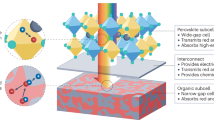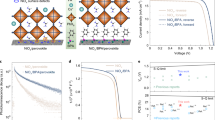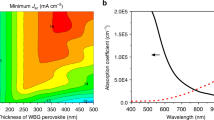Abstract
Multijunction solar cells can overcome the fundamental efficiency limits of single-junction devices. The bandgap tunability of metal halide perovskite solar cells renders them attractive for multijunction architectures1. Combinations with silicon and copper indium gallium selenide (CIGS), as well as all-perovskite tandem cells, have been reported2,3,4,5. Meanwhile, narrow-gap non-fullerene acceptors have unlocked skyrocketing efficiencies for organic solar cells6,7. Organic and perovskite semiconductors are an attractive combination, sharing similar processing technologies. Currently, perovskite–organic tandems show subpar efficiencies and are limited by the low open-circuit voltage (Voc) of wide-gap perovskite cells8 and losses introduced by the interconnect between the subcells9,10. Here we demonstrate perovskite–organic tandem cells with an efficiency of 24.0 per cent (certified 23.1 per cent) and a high Voc of 2.15 volts. Optimized charge extraction layers afford perovskite subcells with an outstanding combination of high Voc and fill factor. The organic subcells provide a high external quantum efficiency in the near-infrared and, in contrast to paradigmatic concerns about limited photostability of non-fullerene cells11, show an outstanding operational stability if excitons are predominantly generated on the non-fullerene acceptor, which is the case in our tandems. The subcells are connected by an ultrathin (approximately 1.5 nanometres) metal-like indium oxide layer with unprecedented low optical/electrical losses. This work sets a milestone for perovskite–organic tandems, which outperform the best p–i–n perovskite single junctions12 and are on a par with perovskite–CIGS and all-perovskite multijunctions13.
This is a preview of subscription content, access via your institution
Access options
Access Nature and 54 other Nature Portfolio journals
Get Nature+, our best-value online-access subscription
$29.99 / 30 days
cancel any time
Subscribe to this journal
Receive 51 print issues and online access
$199.00 per year
only $3.90 per issue
Buy this article
- Purchase on Springer Link
- Instant access to full article PDF
Prices may be subject to local taxes which are calculated during checkout




Similar content being viewed by others
Data availability
The data that support the findings of this study are available from the corresponding authors upon reasonable request.
References
Leijtens, T., Bush, K. A., Prasanna, R. & McGehee, M. D. Opportunities and challenges for tandem solar cells using metal halide perovskite semiconductors. Nat. Energy 3, 828–838 (2018).
Hou, Y. et al. Efficient tandem solar cells with solution-processed perovskite on textured crystalline silicon. Science 367, 1135–1140 (2020).
Han, Q. et al. High-performance perovskite/Cu(In,Ga)Se2 monolithic tandem solar cells. Science 361, 904–908 (2018).
Lin, R. et al. Monolithic all-perovskite tandem solar cells with 24.8% efficiency exploiting comproportionation to suppress Sn(II) oxidation in precursor ink. Nat. Energy 4, 864–873 (2019).
Palmstrom, A. F. et al. Enabling flexible all-perovskite tandem solar cells. Joule 3, 2193–2204 (2019).
Yan, C. et al. Non-fullerene acceptors for organic solar cells. Nat. Rev. Mater. 3, 18003 (2018).
Liu, Q. et al. 18% Efficiency organic solar cells. Sci. Bull. 65, 272–275 (2020).
Mahesh, S. et al. Revealing the origin of voltage loss in mixed-halide perovskite solar cells. Energy Environ. Sci. 13, 258–267 (2020).
Li, C., Wang, Y. & Choy, W. C. H. Efficient interconnection in perovskite tandem solar cells. Small Methods 4, 2000093 (2020).
Chen, X. et al. Efficient and reproducible monolithic perovskite/organic tandem solar cells with low-loss interconnecting layers. Joule 4, 1594–1606 (2020).
Zhan, L. et al. Over 17% efficiency ternary organic solar cells enabled by two non-fullerene acceptors working in an alloy-like model. Energy Environ. Sci. 13, 635–645 (2020).
Degani, M. et al. 23.7% Efficient inverted perovskite solar cells by dual interfacial modification. Sci. Adv. 7, 7930 (2021).
Al-Ashouri, A. et al. Conformal monolayer contacts with lossless interfaces for perovskite single junction and monolithic tandem solar cells. Energy Environ. Sci. 12, 3356–3369 (2019).
Shockley, W. & Queisser, H. J. Detailed balance limit of efficiency of p–n junction solar cells. J. Appl. Phys. 32, 510–519 (1961).
Graetzel, M. The light and shade of perovskite solar cells. Nat. Mater. 13, 838–842 (2014).
McMeekin, D. P. et al. A mixed-cation lead mixed-halide perovskite absorber for tandem solar cells. Science 351, 151–155 (2016).
Tao, S. et al. Absolute energy level positions in tin- and lead-based halide perovskites. Nat. Commun. 10, 2560 (2019).
Hao, F., Stoumpos, C. C., Chang, R. P. H. & Kanatzidis, M. G. Anomalous band gap behavior in mixed Sn and Pb perovskites enables broadening of absorption spectrum in solar cells. J. Am. Chem. Soc. 136, 8094–8099 (2014).
Zhao, D. et al. Efficient two-terminal all-perovskite tandem solar cells enabled by high-quality low-bandgap absorber layers. Nat. Energy 3, 1093–1100 (2018).
Green, M. A. et al. Solar cell efficiency tables (version 56). Prog. Photovolt. Res. Appl. 28, 629–638 (2020).
Yu, G., Gao, J., Hummelen, J. C., Wudl, F. & Heeger, A. J. Polymer photovoltaic cells: enhanced efficiencies via a network of internal donor-acceptor heterojunctions. Science 270, 1789–1791 (1995).
Zhao, J. et al. Efficient organic solar cells processed from hydrocarbon solvents. Nat. Energy 1, 15027 (2016).
Cheng, P., Li, G., Zhan, X. & Yang, Y. Next-generation organic photovoltaics based on non-fullerene acceptors. Nat. Photon. 12, 131–142 (2018).
Qian, D. et al. Design rules for minimizing voltage losses in high-efficiency organic solar cells. Nat. Mater. 17, 703–709 (2018).
Liu, J. et al. Fast charge separation in a non-fullerene organic solar cell with a small driving force. Nat. Energy 1, 16089 (2016).
Yuan, J. et al. Single-junction organic solar cell with over 15% efficiency using fused-ring acceptor with electron-deficient core. Joule 3, 1140–1151 (2019).
Yu, R. et al. Improved charge transport and reduced nonradiative energy loss enable over 16% efficiency in ternary polymer solar cells. Adv. Mater. 31, 1902302 (2019).
Zhu, Y. et al. Rational strategy to stabilize an unstable high-efficiency binary nonfullerene organic solar cells with a third component. Adv. Energy Mater. 9, 1900376 (2019).
Gasparini, N. et al. Exploiting ternary blends for improved photostability in high-efficiency organic solar cells. ACS Energy Lett. 5, 1371–1379 (2020).
Du, X. et al. Unraveling the microstructure-related device stability for polymer solar cells based on nonfullerene small-molecular acceptors. Adv. Mater. 32, 1908305 (2020).
Slotcavage, D. J., Karunadasa, H. I. & McGehee, M. D. Light-induced phase segregation in halide-perovskite absorbers. ACS Energy Lett. 1, 1199–1205 (2016).
Peña-Camargo, F. et al. Halide segregation versus interfacial recombination in bromide-rich wide-gap perovskite solar cells. ACS Energy Lett. 5, 2728–2736 (2020).
Stolterfoht, M. et al. Approaching the fill factor Shockley–Queisser limit in stable, dopant-free triple cation perovskite solar cells. Energy Environ. Sci. 10, 1530–1539 (2017).
Knight, A. J. & Herz, L. M. Preventing phase segregation in mixed-halide perovskites: a perspective. Energy Environ. Sci. 13, 2024–2046 (2020).
Park, B.-W. et al. Understanding how excess lead iodide precursor improves halide perovskite solar cell performance. Nat. Commun. 9, 3301 (2018).
Jiang, Q. et al. Surface passivation of perovskite film for efficient solar cells. Nat. Photon. 13, 460–466 (2019).
Doung, T. et al. High efficiency perovskite-silicon tandem solar cells: effect of surface coating versus bulk incorporation of 2D perovskite. Adv. Energy Mater. 10, 1903553 (2020).
Brinkmann, K. O. et al. Suppressed decomposition of organometal halide perovskites by impermeable electron-extraction layers in inverted solar cells. Nat. Commun. 8, 13938 (2017).
Behrendt, A. et al. Highly robust transparent and conductive gas diffusion barriers based on tin oxide. Adv. Mater. 27, 5961–5967 (2015).
Gahlmann, T. et al. Impermeable charge transport layers enable aqueous processing on top of perovskite solar cells. Adv. Energy Mater. 10, 1903897 (2020).
Gu, S. et al. Tin and mixed lead–tin halide perovskite solar cells: progress and their application in tandem solar cells. Adv. Mater. 32, 1907392 (2020).
Zhang, S. & Scheu, C. Evaluation of EELS spectrum imaging data by spectral components and factors from multivariate analysis. Microscopy 67, 133–141 (2018).
Becker, T. et al. All-oxide MoOx/SnOx charge recombination interconnects for inverted organic tandem solar cells. Adv. Energy Mater. 8, 1702533 (2018).
Meyer, J. et al. Transition metal oxides for organic electronics: energetics, device physics and applications. Adv. Mater. 24, 5408–5427 (2012).
Hagleitner, D. R. et al. Bulk and surface characterization of In2O3(001) single crystals. Phys. Rev. B 85, 115441 (2012).
Lany, A. et al. Surface origin of high conductivities in undoped In2O3 thin films. Phys. Rev. Lett. 108, 016802 (2012).
Bellingham, J. R., Phillips, W. A. & Adkins, C. J. Intrinsic performance limits in transparent conducting oxides. J. Mater. Sci. Lett. 11, 263–265 (1992).
Hoffmann, L. et al. Spatial atmospheric pressure atomic layer deposition of tin oxide as an impermeable electron extraction layer for perovskite solar cells with enhanced thermal stability. ACS Appl. Mater. Interfaces 10, 6006–6013 (2018).
Brinkmann, K. O. et al. The optical origin of near-unity external quantum efficiencies in perovskite solar cells. Sol. RRL 9, 2100371 (2021).
Brinkmann, K. O. et al. Extremely robust gas-quenching deposition of halide perovskites on top of hydrophobic hole transport materials for inverted (p–i–n) solar cells by targeting the precursor wetting issue. ACS Appl. Mater. Interfaces 11, 40172–40179 (2019).
Libera, J. A., Hryn, J. N. & Elam, J. W. Indium oxide atomic layer deposition facilitated by the synergy between oxygen and water. Chem. Mater. 23, 2150–2158 (2011).
Zardetto, V. et al. Atomic layer deposition for perovskite solar cells: research status, opportunities and challenges. Sustain. Energy Fuels 1, 30–55 (2017).
Wei, W. & Hu, Y. W. Catalytic role of H2O in degradation of inorganic–organic perovskite (CH3NH3PbI3) in air. Int. J. Energy Res. 41, 1063–1069 (2017).
Yang, J., Siempelkamp, B. D., Liu, D. & Kelly, L. D. Investigation of CH3NH3PbI3 degradation rates and mechanisms in controlled humidity environments using in situ techniques. ACS Nano 9, 1955–1963 (2015).
Timmreck, R. et al. Characterization of tandem organic solar cells. Nat. Photon. 9, 478–479 (2015).
Zhang, S. et al. Different photostability of BiVO4 in near-pH-neutral electrolytes. ACS Appl. Energy Mater. 3, 9523–9527 (2020).
Shiga, M. et al. Sparse modeling of EELS and EDX spectral imaging data by nonnegative matrix factorization. Ultramicroscopy 170, 43–59 (2016).
Wurfel, P. The chemical potential of radiation. J. Phys. C 15, 3967–3985 (1982).
Würfel P. & Würfel U. Physics of Solar Cells: From Basic Principles to Advanced Concepts (Wiley, 2016).
Acknowledgements
We acknowledge the Deutsche Forschungsgemeinschaft (DFG) (within the SPP 2196: grant numbers RI 1551/15-1, RI 1551/12-1; individual grant numbers: RI 1551/18-1, RI 1551/4-3, RI 1551/7-2 and HE 2698/7-2), the Bundesministerium für Bildung und Forschung (BMBF) (grant number: 01DP20008) and the Bundesministerium für Wirtschaft und Energie (BMWi) (grant number: ZF4037809DF8) for financial support. The research leading to these results has received partial funding from the European Union’s Horizon 2020 Programme under grant agreement no. 951774 (FOXES). This work was also partially funded by the European Regional Development Fund (ERDF) (grant number: EFRE 0801507), S.O. and C. Koch further thank the SCALUP project. (SOLAR-ERA.NET Cofund 2, id: 32). We thank Mountain Photonics for providing us with a Prizmatix high-power white LED as well as Tesa Germany for providing us with sealing duct tape. We also thank J. Wang and R. Janssen from the Eindhoven University of Technology for their support in verifying some EQE values reported in this work. We thank B. Gault and A. Sturm from the Max-Planck-Institut für Eisenforschung GmbH for help with the FIB and for enabling the STEM measurements. We also thank the ESRF for the admission of X-ray diffraction measurements and gratefully appreciate the support by our local contacts O. Konovalov and M. Jankowski. Finally, we acknowledge J. Hohl-Ebinger from the Fraunhofer ISE CalLab for valuable consultation throughout the certification process.
Author information
Authors and Affiliations
Contributions
T.R., T.B. and K.O.B. conceived and designed the experiments. S.O. and C. Koch contributed the XPS, UPS and IPES analysis. K.O.B., T.B., F.Z., C. Kreusel, M.G., T.M., C.T. and F.G. performed the experimental work on the solar cells. T.G. and M.T. contributed the metal oxide ALD layers as well as electrical characterization. T.H. did the cross-section SEM measurements. P.C., L.P.-T., D.N. and M.S. designed, conducted and evaluated the PLQY/QFLS studies. A.A.-A. and S.A. provided the expertise in the processing of the self-assembled monolayers. D.H. and K.M. contributed temperature-dependent J–V characterization. L.M., A.H. and F.S. designed and conducted the GIWAXS and L.G. and S.Z. the HAADF-STEM and EDS studies. All authors discussed the results and were involved in the writing.
Corresponding authors
Ethics declarations
Competing interests
The authors declare no competing interests.
Peer review
Peer review information
Nature thanks the anonymous reviewers for their contribution to the peer review of this work.
Additional information
Publisher’s note Springer Nature remains neutral with regard to jurisdictional claims in published maps and institutional affiliations.
Supplementary information
Supplementary Information
Supplementary text, figures, notes and references.
Rights and permissions
About this article
Cite this article
Brinkmann, K.O., Becker, T., Zimmermann, F. et al. Perovskite–organic tandem solar cells with indium oxide interconnect. Nature 604, 280–286 (2022). https://doi.org/10.1038/s41586-022-04455-0
Received:
Accepted:
Published:
Issue Date:
DOI: https://doi.org/10.1038/s41586-022-04455-0
This article is cited by
-
Perovskite–organic tandem solar cells
Nature Reviews Materials (2024)
-
Suppression of phase segregation in wide-bandgap perovskites with thiocyanate ions for perovskite/organic tandems with 25.06% efficiency
Nature Energy (2024)
-
Breaking the reaction chain
Nature Energy (2024)
-
Redox mediator-stabilized wide-bandgap perovskites for monolithic perovskite-organic tandem solar cells
Nature Energy (2024)
-
Perovskite/silicon tandem solar cells–compositions for improved stability and power conversion efficiency
Photochemical & Photobiological Sciences (2024)
Comments
By submitting a comment you agree to abide by our Terms and Community Guidelines. If you find something abusive or that does not comply with our terms or guidelines please flag it as inappropriate.



